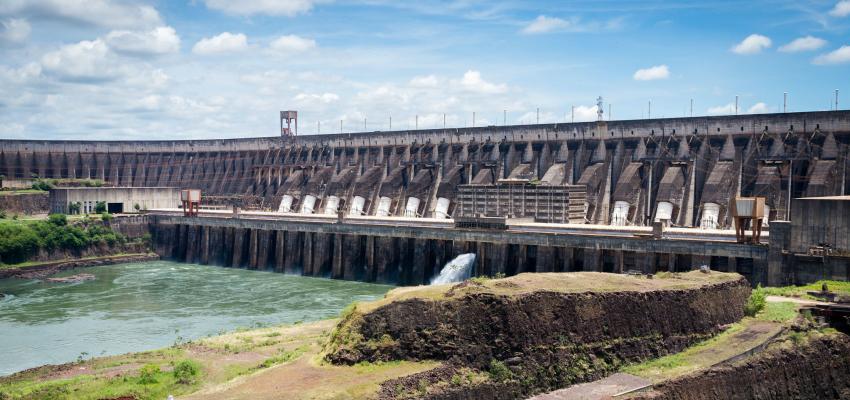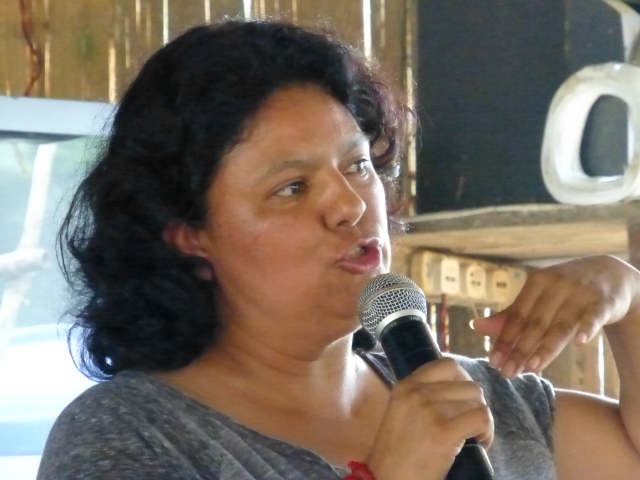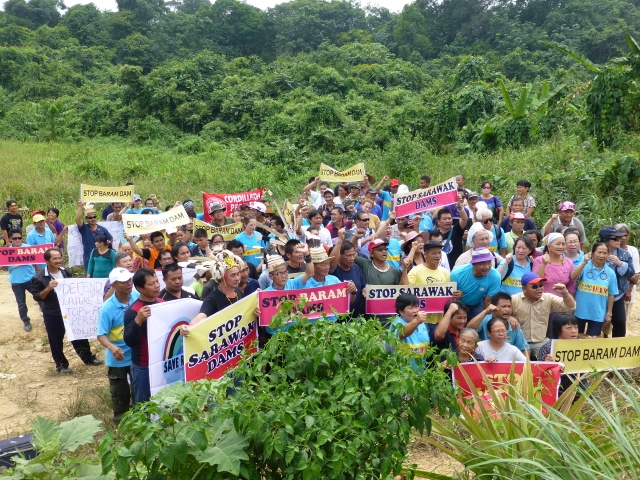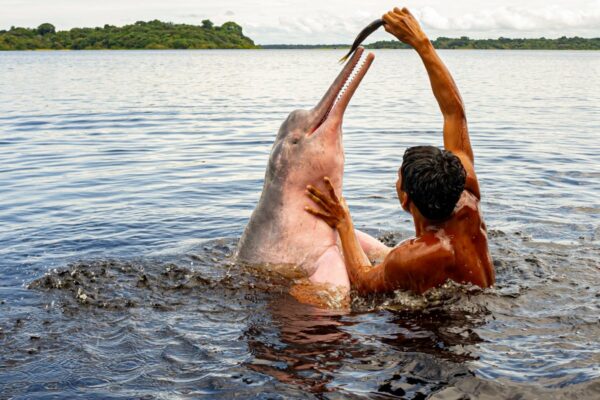
A coalition of more than three hundred civil society organisations from 53 countries has launched a manifesto calling on government leaders and financiers at the Paris climate talks to keep large hydropower projects out of climate initiatives.
Mega-dams should not be getting support from such initiatives as the Clean Development Mechanism (CDM), the World Bank’s Climate Investment Funds, and green bonds, the manifesto signatories say.
The “Civil Society Manifesto for the Support of Real Climate Solutions” challenges the belief that mega-dams are a “clean and green” source of electricity.
Large hydropower projects emit massive amounts of methane, make water and energy systems more vulnerable to climate change, and cause severe damage to critical ecosystems and local communities, the manifesto signatories say.
“Including them in climate initiatives crowds out support for true climate solutions such as wind and solar power, which have become readily available, can be built more quickly than large dams, and have a smaller social and environmental footprint.”
Building more dams to protect ecosystems from climate change “means sacrificing the planet’s arteries to protect her lungs”, the manifesto states.
“Support from climate initiatives is one of the reasons why more than 3,700 hydropower dams are currently under construction and in the pipeline. Yet large hydropower projects are a false solution to climate change.”
Hydropower projects currently make up 26 percent of all projects registered with the CDM, and absorb significant support from other climate initiatives.

The interim executive director of International Rivers, Peter Bosshard, says that hydropower reservoirs emit significant amounts of greenhouse gases, particularly in tropical regions, and the effect is comparable to the climate impact of the aviation sector.
“For environmental, social and economic reasons, large hydropower projects are a false solution to climate change.”
The secretary-general of the Asia Indigenous Peoples Pact (AIPP), Joan Carling, said: “Large hydropower projects have serious impacts on local communities and often violate the rights of indigenous peoples to their lands, cultural integrity and free, prior informed consent.”
The AIPP is one of the manifesto signatories. Others include the South Asia Network on Dams, Rivers and People (SANDRP), the Interamerican Association for Environmental Defense (AIDA), Amazon Watch, Carbon Market Watch, and the Bianca Jagger Human Rights Foundation.
“The resistance of dam-affected communities has often been met with egregious human rights violations,” Carling said.

This is particularly true in Honduras, where four anti-dam activists have been killed and others are under threat. At a recent indigenous peoples’ summit in Malaysia, Berta Cáceres from the Civic Council of Popular and Indigenous Organisations of Honduras said that activists in her country faced enormous repression and aggression.
“The military, police, and hitmen are all sent into our territory. Ten members of our organisation have been murdered; four of them for defending the Gualcarque River.”
The founder of SANDRP, Himanshu Thakkar, said today that hydropower dams make water and energy systems more vulnerable to climate change.
“Dam building has exacerbated flood disasters in fragile mountain areas. At the same time, more extreme droughts increase the economic risks of hydropower, and have greatly affected countries that depend on hydropower dams for most of their electricity.”
The co-executive director of AIDA, Astrid Puentes, points out that wind and solar power have become readily available and financially competitive. “They have overtaken large hydropower in the addition of new capacity.”
Puentes says the countries of the global south should leapfrog obsolete dam projects and promote energy solutions that are gentle for our climate, our environment, and people themselves.
The manifesto signatories point out that large hydropower projects greatly benefit from instruments meant to address climate change, including carbon credits under the CDM, credits from the World Bank’s Climate Investment Funds, and special financial terms from export credit agencies and green bonds.
They say climate finance for large hydropower projects creates the illusion of real climate action.
“Outside climate initiatives, such projects should only go forward under a full assessment of all options as well as strict social and environmental conditions such as those recommended by the World Commission on Dams,” the manifesto states.

Large hydropower projects are often propagated as a “clean and green” source of electricity by international financial institutions, national governments and other actors, the manifesto signatories say.
The manifesto gives detailed reasons why mega-dams should not be included in climate intiatives:
- According to a peer-reviewed study, methane from hydropower reservoirs accounts for more than 4 percent of all human-caused climate change. In some cases, hydropower projects are producing higher emissions than coal-fired power plants while generating the same amount of electricity.
- Rivers take about 200 million tonnes of carbon out of the atmosphere every year. In addition, the silt that rivers like the Amazon, the Congo, the Ganges and the Mekong carry to the sea feeds plankton and absorbs large amounts of carbon. Hydropower projects and other dams disrupt the transport of silt and nutrients and impair the role of rivers to act as global carbon sinks.
- Unprecedented floods are threatening the safety of dams and, in the United States alone, have caused more than 100 dams to fail since 2010. Dam building has exacerbated flood disasters in fragile mountain areas such as Uttarakhand in India. At the same time, more extreme droughts increase the economic risks of hydropower, and have greatly affected countries from Africa to Brazil that depend on hydropower dams for most of their electricity.
- According to the WWF’s 2014 Living Planet report , dam building and other factors have caused freshwater ecosystems to lose an average of 76 percent of their populations since 1970. This is more than the loss suffered in marine and land-based ecosystems.
- Large hydropower projects have serious impacts on local communities and often violate the rights of indigenous peoples to their lands, territories, resources, governance, cultural integrity and free, prior informed consent. Dams have displaced at least 40-80 million people and have negatively affected an estimated 472 million people living downstream.
- In contrast to wind, solar and micro-hydropower, large hydropower dams depend on central electricity grids, which are not a cost-effective tool to reach rural populations, particularly in Sub-Saharan Africa and the Himalayas. Large hydropower projects are often built to meet the demands of mining and industrial projects, even if they are justified by reference to the needs of the poor.
- As grids become smarter and the cost of battery storage drops, new hydropower projects are no longer needed to balance intermittent sources of renewable energy.
The manifesto signatories say that, even if they were a good solution in other ways, large hydropower projects would be a costly and time-consuming way to address the climate crisis. On average large dams experience cost overruns of 96 percent and time overruns of 44 percent.
“In comparison, wind and solar projects can be built more quickly and experience average cost overruns of less than 10 percent.”
Unlike wind and solar power, hydropower is no longer an innovative technology, the manifesto states. “It has not seen major technical breakthroughs in several decades.”
Unlike with solar power, climate funding for large hydropower projects will not bring about further economies of scale, and does not encourage a transfer of new technologies to southern countries, the signatories say.
The dam industry advocates for large hydropower projects to be funded by the Green Climate Fund, and many governments boost them as a response to climate change through national initiatives.
At least twelve governments with major hydropower sectors have included an expansion of hydropower generation in their reports on Intended Nationally Determined Contributions (INDCs).¹
Protestors in many countries face a daunting battle convincing governments and corporations that any benefits mega-dams may bring are far outweighed by the destruction they cause.
However, there have been successes for anti-dam activists in the United Sates, where more than 200 dams have been removed in recent years. More than five thousand large dams remain, of which about 2,540 produce hydropower.
The four dams on the Klamath river are close to being removed in the biggest river restoration project in the world. (The restoration agreements still have to be ratified by the US Congress.)
Fish stocks have been recovering quickly once dams are removed, and trees grow back rapidly as well.
Anti-dam summit in Malaysia
Anti-dam activists gathered in Sarawak on the island of Borneo last month for the World Indigenous Summit on Environment and Rivers. They marked the two-year anniversary of the blockades against the proposed Baram mega-dam in Sarawak.
In their end-of-conference declaration, delegates demanded an end to the building of such dams worldwide, the removal of those that already exist, and full recognition of the rights of indigenous people.

They said governments, multi-national companies, and others should stop presenting dams as climate neutral, and recognise that they emit large amounts of greenhouse gases.
The planned mega-dams in Sarawak would not only flood huge areas of rainforest and displace tens of thousands of indigenous people, they would cause the loss of millions of birds and mammals – and, according to independent experts, the electricity that would be generated is not even needed in the state.
The state government says the dams are required to power future industrial development. It wants to pull investment in to Sarawak, but most of the companies it is eager to attract are engaged in dirty, energy-intensive heavy industries such as aluminium smelting. The corporations are being offered a cheap energy supply that comes at the expense of the local communities and Malaysians overall.
This is a scenario that is being repeated in many countries of the world: dams are built without the agreement of, or even consultation with, local communities, there is massive loss of natural habitats and biodiversity, and the rights of indigenous people are trampled upon as they see their lands and livelihoods destroyed.
When compensation is awarded, it is meagre, and resettlement areas are a very poor substitute for the forests in which people previously lived. And mega-dams are very often operating below their claimed firm capacity.²
If the Baram dam is built, it will cover 38,000 hectares. More than 20,000 people will be displaced and vast areas of rainforest will be submerged.
The Bakun dam, which is the second largest dam in Asia, has already displaced about 10,000 people and flooded 70,000 hectares of rainforest and farmland. Most of the electricity from the dam is being sucked up by the factories in Samalaju, who buy power very cheaply.
The Belo Monte mega-dam in Brazil
The recent decision by the Brazilian Institute of the Environment and Renewable Natural Resources (IBAMA) to authorise the operating licence for the massive Belo Monte hydro-electric complex in the state of Pará shocked and horrified environmentalists.
“We can’t believe it,” said Antonia Melo, leader of the Movimiento Xingú Vivo para Siempre, who has already been displaced by the dam’s construction. “This is a crime. Granting the licence for this monster was an irresponsible decision on the part of the government and the IBAMA.”

Belo Monte is being constructed on the Xingú river, a major Amazon tributary. It will be the third largest hydro-electric complex in the world, comprising three dams: Pimental, Bella Vista, and Belo Monte. There will be two artificial canals, which together will be larger than the Panama Canal.
There are 25 legal actions against the Belo Monte project, but construction is continuing and the complex is close to completion. At least 20,000 workers are being brought in to build it.
AIDA says the licence authorisation has been given “despite clear non-compliance with conditions necessary to guarantee the life, health, and integrity of affected communities”.
About 2,000 people from riverine families have already been displaced in Altamira and the surrounding area, the association adds.
Amazon Watch says Belo Monte will be one of the largest, most devastating infrastructure projects ever built in the Amazon. “As costs rocket above all previous estimates and the full extent of its impacts across the region become more evident, it’s clear that Brazil doesn’t need Belo Monte, and that the project brings destruction – not development – to a precious region.”
There will, Amazon Watch says, be a grave impact on the land and livelihoods of thousands of people living next to the river and in urban areas.
The Belo Monte dam complex is designed to divert eighty percent of the Xingú river’s flow and will devastate more than 1,500 square kilometers of Brazilian rainforest.
According to official statistics, 19,000 people will be forcibly displaced for Belo Monte, mostly from the city of Altamira, but an independent review of the project states that the real number of directly affected people could be twice the official estimate.
The Xingú river basin is a living symbol of Brazil’s cultural and biological diversity; it is home to 25,000 indigenous people from 40 ethnic groups.
Astrid Puentes said: “The authorisation of Belo Monte, a project involved in widespread corruption scandals, contradicts President Rousseff’s recent statement before the United Nations, in which she declared that Brazil would not tolerate corruption, and would instead aspire to be a country where leaders behave in strict accordance with their duties.
“We hope that the Brazilian government comes to its senses, and begins to align its actions with its words.”

Manifesto signatories include Amazon Watch, Asia Indigenous Peoples Pact, Asociación Interamericana para la Defensa del Ambiente, Bianca Jagger Human Rights Foundation, Carbon Market Watch, International Rivers, Jeunes Volontaires pour l’Environnement International, Oxfam International, South Asia Network on Dams, Rivers and People,Urgewald, REDLAR, and Movimiento Ríos Vivos.













